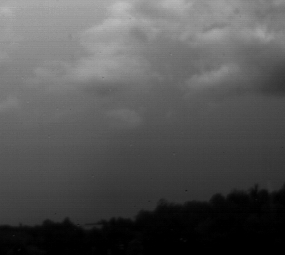Lightning can be divided into two types:
- Flashes with at least one channel connecting the cloud to the ground, known as "cloud-to-ground" discharges (CG); and
- Flashes with no channel to the ground, known as "in-cloud" (IC), "cloud-to-cloud" (CC), or "cloud-to-air" (CA).
The lightning process is more or less the same for both types.
Step 1

A typical CG lightning strike initiates inside the storm. Under the influences of the electric field between the cloud and the ground, a very faint, negatively charged channel called a "stepped leader" emerges from the storm base and propagates toward the ground in a series of steps about 160 feet (50 meters) in length and 1 microsecond (0.000001 seconds) in duration.
In what can be loosely described as an "avalanche of electrons", the stepped leader usually branches out in many directions as it approaches the ground, carrying an EXTREMELY strong electric potential: about 100 MILLION volts with respect to the ground and about 5 coulombs of negative charge.
Between each step, there is a pause of about 50 microseconds, during which the stepped leader "looks" around for an object to strike. If none is "seen", it takes another step, and repeats the process until it "finds" a target.
It takes the stepped leader about 50 milliseconds (1/20th of a second) to reach its full length, though this number varies depending on the length of its path. Studies of individual strikes have shown that a single leader can comprise more than 10,000 steps!
Step 2

As the stepped leader approaches the ground, its strong negative charge repels all other negative charges within the immediate strike zone of the Earth's surface while attracting vast amounts of positive charge. The influx of positive charge into the strike zone is so strong that the stepped leader actually induces electric channels up from the ground known as "streamers".
When one of these positively charged streamers connects with a negatively charged stepped leader (anywhere from 100 to 300 feet (30 to 100 meters) above the surface of the earth), the following steps occur in less than 100 microseconds.
Step 3

The electric potential of the stepped leader is connected to the ground, and the negative charge starts flowing down the established channel.
Step 4

An electric current wave, called a "return stroke", then shoots up the channel, producing a brilliant pulse. It only takes the current about 1 microsecond to reach its peak value, which averages around 30,000 amperes.
This "return stroke" is more than 99% of a lightning bolt's luminosity and is what we see as lightning. The stroke actually travels from the ground into the cloud, but because the strike takes place so quickly, it appears to the unaided eye that the opposite is true.
Step 5

Once the return stroke ceases flowing up the channel, there is a pause of about 20 to 50 milliseconds. If, after the pause, there is enough charge still available within the cloud, another leader can propagate down to the ground. This leader is called a "dart leader" because it uses the channel already established by the stepped leader and therefore has a continuous path.
Dart leaders give lightning its flickering appearance and normally are not branched like the initial stepped leader. Not every lightning flash will produce a dart leader because a sufficient charge to initiate one must be available within about 100 milliseconds of the initial stepped leader.
The dart leader carries additional electric potential to the ground and induces a new streamer from the ground. The dart leader's peak current is usually less than the initial stepped leader and its return stroke has a shorter duration than the initial return stroke. As additional dart leaders are produced, their peak currents and return stroke durations continue to decrease.

Dart leaders and their return strokes don't necessarily use the same cloud-to-ground channel that was burned by the initial stepped leader. If a dart leader takes a different path to the ground, the lightning will appear to dance from one spot to another. This is known as "forked lightning".
The combination of each leader (stepped and dart) and their subsequent return strokes is known collectively as a "stroke". All strokes that use the same channel constitute a single "flash". A flash can be made up of a single stroke or tens of strokes. (The highest number of strokes ever recorded in a single cloud-to-ground flash is 47!)
Notice, in the greatly slowed down animation, the top part of a lightning flash is not connected to anything physical in the cloud, as the cloud itself is not conductive. Instead, the lightning channel branches out inside the cloud in a tree-like shape and draws free electrons to it (the negative charge in the lower half of the thunderstorm).


